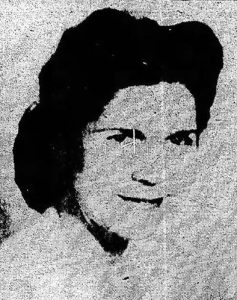US journalist Virginia Snow spent about 15 years in Mexico, reporting for Texas newspapers on all manner of events, Mexican customs, curiosities and meetings from her base in Mexico City.
Born in Detroit, Michigan, on 4 October 1908, she spent the last year of her life in a nursing home in that city, before her death there on 3 April 1959. It was little surprise that she became a journalist, given that her father was a former managing editor of the Detroit Journal. Details of her early career are disappointingly sparse, but she and her sister, Kathleen, were traveling together in Europe in 1938, when they returned to the US barely a year before the second world broke out.

Virginia Snow, 1944.
In 1944, Snow studied Spanish for six months in Mexico City before establishing a home there. She planned to undertake feature writing, illustrated by photographs, which she took, developed and printed herself.
According to a news report about the Texas Pan American Round Table conference in Laredo in 1947, Snow was there as an ‘honored guest’ and had apparently been the originator of the city’s Parade of Flags.
One of the last meetings she attended in Mexico was the 1958 meeting of the Mexico City Association of Foreign Journalists, where she sat in a place of honor at the head table alongside Sr. Estrada and Ing Luis Poyo.
During her lengthy residence in Mexico, Snow was society columnist for the Mexico City Herald, and penned numerous columns about Mexico published in such Texas papers as the Laredo Times, Corpus Christi Times, Brownsville Herald and the Waco Tribune-Herald.
Her columns relating to George Ochoa, including interviews with the accused murderer held in Mexico in 1950 pending his return to Texas, were widely republished across the US. Her “Did You Know” columns about Mexico were full of all manner of fun facts and trivia, ranging from history and ecology to travel and cuisine. (She was clearly a woman after my own heart!)
The opening of her report about Ajijic in 1952 neatly combines historical perspective with then current trends:
I found mastodon teeth in practically every parlor of Ajijic during a recent visit to that Lake Chapala village in Jalisco state. They are a fad in the small American colony of artists, writers, weavers and escapists living in the primitive Village in the Sun.”
Snow then explains how an alarming fall in lake level (due to the diversion of Lerma River waters for dams, irrigation and the Mexico City water supply) had caused the lakeside beaches to disappear, and the white fish to become scarce. On the plus side, it revealed “relics of prehistoric animals,” collected by, among others, “Neill James, whose book Dust on My Heart helped Ajijic to fame,” and Helen Kirtland, “a former New York dress designer, who now designs Mexican sports clothes from her own handloomed fabrics.”
Snow devoted the remainder of her report to the silk business initiated by Neill James, who is “literally living with silk worms. Scores of the wriggling white creatures occupy boxes in her studio bedroom where they are feasting on mulberry leaves and spinning cocoons.”
James was reportedly convinced that the silk industry would be transformative: “Ajijic will be the richest village in Mexico within five years.” She already had “100 Venezuelan mulberry trees” in her own garden, acquired from Dr Varton K. Osigian, a noted Armenian silkworm specialist living in Mexico City, who had given a talk on Ajijic plaza offering grafted mulberry trees for two pesos each, free to anyone who could not afford that price.

Raphael Greno. Undated. Unraveling silk cocoons, Ajijic.
This was the beginning of one of Neill James’ more noteworthy entrepreneurial schemes in Ajijic. Sadly, the enterprise petered out in the mid-1960s, but not before it was captured for posterity in several evocative woodcuts by Rafael Greno.
Foreign Footprints in Ajijic: Decades of Change in a Mexican Village offers a comprehensive account of Neill James, Helen Kirtland, the silk industry and what Ajijic was like in the past.
Sources
- The Brownsville Herald: 17 Oct 1944, 3; 19 Nov 1947.
- Corpus Christi Times (Texas): 6 Oct 1950; 7 Oct 1950.
- El Espiritu Publico (Campeche): 1 July 1958, 8.
- El Paso Times: 5 Apr 1959, Page 57.
- Laredo Times: 3 Jul 1949, 5; 10 Jan 1950, 1; 7 Oct 1950.
- Virginia Snow. 1952. “The Mexican Parade.” Waco Tribune-Herald 6 Jan 1952, 30.
- ——— 1956. “The Mexican Parade: Souped-up Silk Worms and Modern Machinery Lead to New Industry.” Waco Tribune-Herald, 4 March, 1956.
Comments, corrections and additional material welcome, whether via comments feature or email.
Tony Burton’s books include “Lake Chapala: A Postcard History” (2022), “Foreign Footprints in Ajijic” (2022), “If Walls Could Talk: Chapala’s historic buildings and their former occupants” (2020), (available in translation as “Si Las Paredes Hablaran”), “Mexican Kaleidoscope” (2016), and “Lake Chapala Through the Ages” (2008).
Fascinating –and when one grasps the infrastructure of Mexico during her times versus today–some of the activities are almost incredible –I can recall Northern Mexico in the 1960s–wonder how long a trip from Mex city to Gdl took then–thanks for another informative column
Bill, Thanks; glad you enjoyed the column. Mexico City to Guadalajara did not take an outrageous amount of time in the 1960s – there was an efficient overnight passenger train service. Even at the very end of the 19th century it took less than a day by train (via Irapuato).